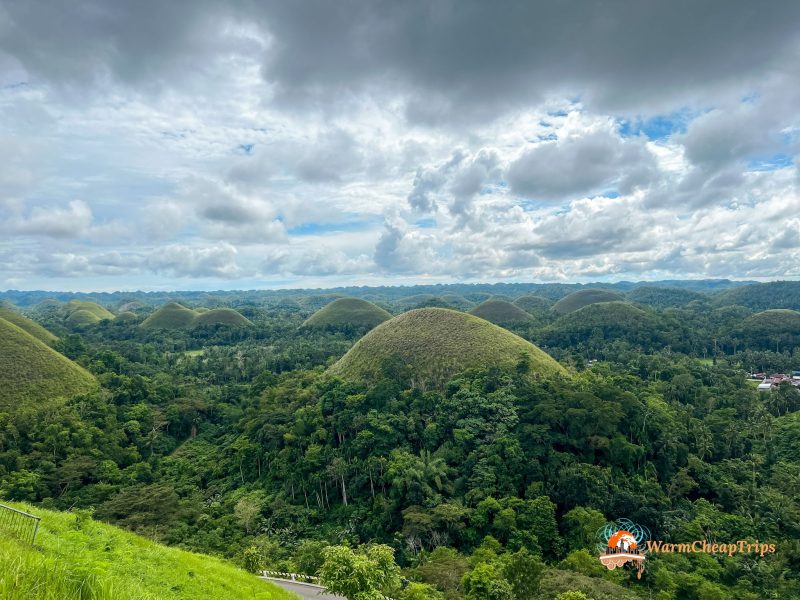I had never started a new year with my feet in white sand, facing a crystal-clear sea, right after experiencing one of the most magical moments of my life: watching hundreds of fireflies from a kayak in the jungle. To be honest, I had never even dreamed of beginning a year like that.
Yet, it really happened.
It was a late October afternoon when, while looking back at photos from our trip to Palawan the year before, we decided to check flights for New Year’s week. We found a super cheap one to Cebu, booked it immediately, and I started planning possible stops and things to see. That’s when the unique nature of Bohol and the beaches of Panglao—just a few hours away by ferry—caught my attention. I knew instantly that this was the place where we’d welcome the new year.
Bohol and Panglao are two Philippine islands connected by road bridges, and they’re usually visited together on a 3–4 day trip that combines Bohol’s lush landscapes with Panglao’s idyllic beaches. They’re quite a popular destination, especially with Asian and domestic tourists, and more developed than Palawan in some respects—though Palawan is quickly catching up thanks to international tourism.


What to See in Bohol
Bohol is the perfect island for nature lovers: lush vegetation, waterfalls, and pristine beaches. Life here is very much local, but there are three main reasons people come: the Chocolate Hills, the tarsiers, and the Loboc River.
You can explore Bohol’s main attractions by renting a scooter, joining one of the many tours offered everywhere on both Bohol and Panglao, or booking through your accommodation. We chose a private transfer with Albert’s agency, since we also needed a pick-up from Ubay port.


Chocolate Hills
These UNESCO-listed natural formations are Bohol’s unique landmark and a must-see. The Chocolate Hills are cone-shaped hills that turn brown during the dry season, resembling chocolates. Even when they’re green, the view from the observation deck is breathtaking: a sea of perfectly shaped hills stretching as far as the eye can see.
The origin of the Chocolate Hills isn’t certain, but they’re thought to be ancient coral deposits revealed by erosion. A true natural wonder—just like Palawan’s incredible underground river.
The viewpoint has an entrance fee of 150 pesos, and from the parking area there are about 200 steps up to the observation platform. The view will leave you breathless (and not just because of the climb!).
The Tarsier of Bohol
The tarsier is a tiny primate, only up to 160 mm long and weighing about 160 grams. It can leap up to 5 meters and has huge eyes fixed in its small head, which can rotate 180° left and right. These little “Yodas” are delicate creatures and sadly endangered, but Bohol is one of the few places where you can still find them. Thanks to government protection and sanctuaries, you can observe them in their natural forest habitat.
Not all sanctuaries are respectful—some are more “tourist friendly” than “tarsier friendly.” Based on local advice and research, we chose the Tarsier Sanctuary in Corella, which truly cares for the animals. Visits are in small groups (about 8 people) with a guide, after watching an educational video. Rules are strict: no talking, no flash, no selfie sticks, no touching!
Tarsiers are extremely sensitive—if stressed, frightened, or touched, they can even commit suicide by hitting their heads or holding their breath. Since they’re nocturnal, they usually nap during the day, making it rare to see them with their big eyes wide open.
There is a contribution fee for the conservation of 150 pesos. The guided path runs through the forest, so wear shoes suitable for muddy terrain (there’s a water hose near the bathrooms to rinse them off afterward).


Loboc River
The Loboc River is a peaceful waterway through the jungle, where at night you can witness countless fireflies. For thrill seekers, there’s also a zipline offering a bird’s-eye view of the river and forest. During the day, river cruises with lunch are offered, but we chose to stay in an ecolodge on its banks for a deeper experience. From Water to Forest Ecolodge, we took a kayak trip at sunset, paddling into the dark until we reached areas where fireflies gathered. Drifting under the jungle sounds was magical enough, but when the trees lit up with glowing fireflies, it felt like staring at a natural Christmas tree.
Unfortunately, the moment was sometimes interrupted by the noise of tourist boats on night cruises. These disturb the fireflies, and over time could make them disappear—just like in many of our countryside areas back home. Being responsible tourists means leaving as little trace as possible. So I highly recommend skipping those boat tours and choosing the much quieter kayak experience.


On the topic of ethical tourism: during our visit, tours were still offered in Lila to swim with whale sharks. Just like in Oslob, they were being fed to alter their migratory routes for tourists’ sake, often injuring themselves against the many boats. We refused to take part and were glad to learn that a few months later, the provincial government banned whale shark swimming in Lila.
If you’d like to have this experience responsibly, I suggest Pintuyan (the previous stop on our trip), which I’ll write about soon.


What to See in Panglao
If Bohol is about landscapes, Panglao is about beaches. This small island, connected by two bridges, is famous for powdery white sand and turquoise waters. It has grown a lot in recent years, popular especially with Asian tourists (mainly Koreans and Japanese).
Panglao Beaches
The heart of Panglao’s day and nightlife is Alona Beach, where we joined the New Year’s Eve countdown with music, cocktails, and fireworks over the sea. Alona is paradise: blindingly white sand and crystal-clear shallow water, perfect for strolling or sunbathing. Sunsets here are spectacular. The beachfront is lined with restaurants and bars, plus a convenience store and ATM. Most accommodations, shops, and exchanges are here too—prices are higher, but even over New Year’s, it never felt overcrowded. The beach is long, so you can always find a quieter spot. A few palm trees provide shade (coveted spots!), and while we did find some seaweed at the shoreline, once past that the water was simply incredible.
Other stunning beaches are Dumaluan Beach and White Beach—quieter than Alona but just as breathtaking. We stayed at D&B Bluestar Beach Resort, with direct access to White Beach. Here we found powder sand, crystal waters, giant starfish, and only a few food stalls and stray dogs. No seaweed, but corals and sea urchins near the shore make swimming at low tide trickier.


Excursion to Balicasag & Virgin Island (temporarily closed)
The most promoted excursion is snorkeling at Balicasag, usually combined with dolphin watching and a stop at Virgin Island. However, since September 2024 Virgin Island has been closed due to overtourism damage—hopefully it will recover.
To be honest, the way Balicasag tours are run, it’s no wonder Virgin Island had to be shut down. Boats all converge at the same time, guides push tourists to chase turtles, and many step on corals with reef shoes when tired of swimming. The result? More legs than fish in the water, boats dodging bodies, and stressed turtles. An awful, non-recommended experience—don’t waste your money.


Excursion to Pamilacan
Pamilacan, on the other hand, is the definition of a tropical paradise: palm trees, white sand, turquoise water, rich coral reefs with colorful fish and turtles, and far fewer people. Dolphin watching is also included, but in a quieter area at sunrise. Life jackets are mandatory here to protect the corals, and since tours are private, you can decide how long to stay. The beach where the bangkas dock is gorgeous, with a small restaurant and a few lodges—spending a night must be unforgettable if you have time.
We first booked through Alona Beach vendors (after a disappointing Balicasag trip arranged by our hotel), but it turned into an even worse experience. Our boat never arrived, we waited 1.5 hours, missed the dolphins, and had to call the police to get our deposit refunded! Sadly, scams like this are common among Alona vendors, who take advantage of tourists not chasing after €10 deposits.
Luckily, local fishermen we met at White Beach—angry at how these scammers damage the island’s reputation—helped us. They suggest me to report that vendor to the police and arranged a private boat to Pamilacan, and it turned out to be the best snorkeling ever: countless fish, turtles, and even spotting a dangerous sea snake (walo-walo)!
Costs: 2,000 pesos for the boat, 250 pesos per person entrance fee, 600 pesos for a snorkeling guide, and 150 pesos per person for mask/snorkel rental (free if you bring your own).


How to Get to Bohol
Bohol is well connected to Cebu with frequent Oceanjet ferries arriving at Tagbilaran port. Book tickets online in advance, especially during high season, to avoid long waits. The fare is 870 pesos. You can choose indoor (with aircon) or outdoor seats—I recommend outdoors, as you’re shaded but spared the freezing AC.
Panglao also has a small airport, but flights are less frequent and usually not very cheap.
On the islands, you can rent a scooter or use Grab, which is super convenient for getting around, especially to and from the port.


Where to stay
The general recommendation is to stay in Panglao and visit Bohol as a day trip.
Personally, however, I really loved spending the night at the Water to Forest Ecolodge located on the banks of the Loboc River. At the end of a road in a tiny, super-local village, the lodge is made up of stilt houses practically without walls, closed only by curtains. There’s no air conditioning, but there are fans that keep working even during the nightly power cuts, while you fall asleep surrounded by the sounds of nature (safely tucked under a mosquito net around the bed). Bathrooms are shared, and it’s possible to arrange SUP and kayak outings, along with other excursions. A true immersion in nature, which I personally loved even more than The Isla Experience in El Nido. While similar in concept, that one felt a bit more “touristy” by comparison. Meals are not included, but there’s a café on site where you can order breakfast, lunch, and dinner. Prices are a bit higher, but the food is really tasty and the portions generous. Just over €25 per night.
For Panglao, we preferred to avoid staying in the busy Alona Beach area, but we still wanted to be within walking distance of the shore. Luckily, we found availability at the D&B Bluestar Beach Resort which, despite the name, is a regular hotel with fairly spacious rooms, a shower area separate from the rest of the bathroom, and an outdoor terrace or porch — a bit like a seaside apartment, just without a kitchen!
Right on the beach, it also has a small garden with hammocks and lounge chairs under the trees for those who prefer shade. Breakfast is included, and they can prepare simple meals for lunch and dinner on request, but honestly, the food was quite disappointing. It’s possible to rent scooters and arrange excursions directly from the hotel. Definitely the most expensive accommodation of the trip — about €60 per night — but we stayed there over New Year’s, from December 31st to January 3rd.


As with much of the Philippines (especially the west), the best season to visit Bohol and Panglao is November/December to May, making them a great New Year destination. Plan for at least 3 days, and you can easily combine them with Cebu.
Planning a trip to the Philippines? You’ll find more tips here!


Did you find this article useful? Buy me a coffee 🙂



